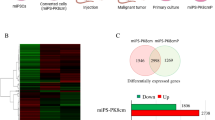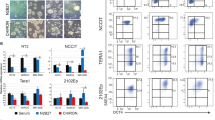Abstract
Lin28 and Oct4 are highly expressed in human embryonic stem (ES) cells and, along with two other stem cell marker proteins (Nanog and Sox2), together can convert human somatic cells to pluripotency. As an RNA-binding protein, Lin28 acts to stimulate the translation of a specific subset of mRNAs, and to inhibit the biogenesis of a group of microRNAs. Oct4 is a transcription factor essential for the maintenance of pluripotency and survival of ES cells. In this study, we report that a sub-population of epithelial ovarian cancer (EOC) cells co-expresses Lin28 and Oct4 as demonstrated in the analyses of both cell lines and patient tumor samples. We also observe that the combined expression of these proteins in tumor samples is correlated with advanced tumor grade. Intriguingly, when the expression of these two proteins is repressed in the same cells using RNA interference, there is significant reduction in cell growth and survival. We thus propose that Lin28 and Oct4 may have important roles in the initiation and/or progression of EOC, and consequently may serve as important molecular diagnostics and/or therapeutic targets for the development of novel treatment strategies in EOC patients.
This is a preview of subscription content, access via your institution
Access options
Subscribe to this journal
Receive 50 print issues and online access
$259.00 per year
only $5.18 per issue
Buy this article
- Purchase on Springer Link
- Instant access to full article PDF
Prices may be subject to local taxes which are calculated during checkout




Similar content being viewed by others
References
Alvero AB, Chen R, Fu HH, Montagna M, Schwartz PE, Rutherford T et al. (2009). Molecular phenotyping of human ovarian cancer stem cells unravels the mechanisms for repair and chemoresistance. Cell Cycle 8: 158–166.
Assou S, Cerecedo D, Tondeur S, Pantesco V, Hovatta O, Klein B et al. (2009). A gene expression signature shared by human mature oocytes and embryonic stem cells. BMC Genomics 10: 10. (doi:10.1186/1471-2164-10-10).
Benard J, Da Silva J, De Blois M-C, Boyer P, Duvillard P, Chiric E et al. (1985). Characterization of a human ovarian adenocarcinoma Line, IGROV1, in tissue culture and in nude mice. Cancer Research 45: 4970–4979.
Bussing I, Slack FJ, Großhans H . (2008). Let-7 microRNAs in development, stem cells and cancer. Trends Mol Med 14: 400–409.
Chen Z, Xu W, Qian H, Zhu W, Bu X, Wang S et al. (2009). Oct4, a novel marker for human gastric cancer. J Surg Onco 99: 414–419.
Cheng L, Sung M-T, Cossu-Rocca P, Jones TD, MacLennan GT, De Jong J et al. (2007). OCT4: biological functions and clinical applications as a marker of germ cell neoplasia. J Pathol 211: 1–9.
Dangi-Garimella S, Yun J, Eves EM, Newman M, Erkeland SJ, Hammond SM et al. (2009). Raf kinase inhibitory protein suppresses a metastasis signaling cascade involving LIN28 and let-7. EMBO J 28: 347–358.
Darr H, Benvenisty N . (2008). Genetic analysis of the role of the reprogramming gene LIN-28 in human embryonic stem cells. Stem Cells 27: 352–362.
Fodde R . (2009). The stem of cancer. Cancer Cell 15: 87–89.
Heo I, Joo C, Cho J, Ha M, Han J, Kim NV . (2008). Lin28 mediates the terminal uridylation of let-7 precursor microRNA. Mol Cell 32: 276–284.
Heo I, Joo C, Kim YK, Ha M, Yoon MJ, Cho J et al. (2009). TUT4 in concert with Lin28 suppresses microRNA biogenesis through pre-microRNA Uridylation. Cell 138: 696–708.
Hu T, Liu S, Breiter DR, Wang F, Tang Y, Sun S . (2008). Octamer 4 small interfering RNA results in cancer stem cell-like cell apoptosis. Cancer Res 68: 6533–6540.
Jinawath N, Vasoontara C, Yap K-L, Thiaville MM, Nakayama K, Wang T-L et al. (2009). NAC-1, a potential stem cell pluripotency factor, contributes to paclitaxel resistance in ovarian cancer through inactivating Gadd45 pathway. Oncogene 28: 1941–1948.
Jordan CT . (2009). Cancer stem cells: controversial or just misunderstood? Cell Stem Cell 4: 203–205.
Lu L, Katsaros D, Shaverdashvili K, Qian B, Wu Y, de la Longrais IA et al. (2009). Pluripotent factor lin-28 and its homologue lin-28b in epithelial ovarian cancer and their associations with disease outcomes and expression of let-7a and IGF-II. Eur J Cancer 45: 2212–2218.
Marotta LL, Polyak K . (2009). Cancer stem cells: a model in the making. Curr Opin Genet Dev 19: 44–50.
Moss EG, Lee RC, Ambros V . (1997). The cold shock domain protein LIN-28 controls developmental timing in C. elegans and is regulated by the lin-4 RNA. Cell 88: 637–646.
Moss EG, Tang L . (2003). Conservation of the heterochronic regulator Lin-28, its developmental expression and microRNA complementary sites. Dev Biol 258: 432–442.
Newman MA, Thomson JM, Hammond SM . (2008). Lin-28 interaction with the Let-7 precursor loop mediates regulated microRNA processing. RNA 14: 1539–1549.
Pei D . (2009). Regulation of pluripotency and reprogramming by transcription factors. J Biol Chem 284: 3365–3369.
Polesskaya A, Cuvellier S, Naguibneva I, Duquet A, Moss EG, Harel-Bellan A . (2007). Lin-28 binds IGF-2 mRNA and participates in skeletal myogenesis by increasing translation efficiency. Genes Dev 21: 1125–1138.
Qiu C, Ma Y, Wang J, Peng S, Huang Y . (2009). Lin28-mediated post-transcriptional regulation of Oct4 expression in human embryonic stem cells. Nucleic Acids Res (doi:10.1093/nar/gkp1071).
Richard M, Tan SP, Tan JH, Chan WK, Bongso A . (2004). The transcriptome profile of human embryonic stem cells as defined by SAGE. Stem Cells 22: 51–64.
Rybak A, Fuchs H, Smirnova L, Brandt C, Pohl EE, Nitsch R et al. (2008). A feedback loop comprising lin-28 and let-7 controls pre-let-7 maturation during neural stem-cell commitment. Nat Cell Biol 10: 987–993.
Trabucchi M, Briata P, Carcia-Mayoral M, Haase AD, Filipowicz W, Ramos A et al. (2009). The RNA-binding protein KSRP promotes the biogenesis of a subset of microRNAs. Nature 459: 1010–1014.
Vasey PA . (2008). Ovarian cancer: front-line standard treatment in 2008. Ann Oncol 19 (Suppl 7): vii61–vii66.
Viswanathan SR, Daley GQ, Gregory RI . (2008). Selective blockade of microRNA processing by Lin-28. Science 320: 97–100.
Viswanathan SR, Powers JT, Einhorn W, Hoshida Y, Ng TL, Toffanin S et al. (2009). Lin28 promotes transformation and is associated with advanced human malignancies. Nat Genet 41: 843–848.
Xu B, Huang Y . (2009). Histone H2a mRNA interacts with Lin28 and contains a Lin28-dependent posttranscriptional regulatory element. Nucleic Acids Res 37: 4256–4263.
Xu B, Zhang K, Huang Y . (2009). Lin28 modulates cell growth and associates with a subset of cell cycle regulator mRNAs in mouse embryonic stem cells. RNA 15: 357–361.
Yang DH, Moss EG . (2003). Temporally regulated expression of Lin-28 in diverse tissues of the developing mouse. Gene Expr Patterns 3: 719–726.
Yu J, Vodyanik MA, Smuga-Otto K, Antosiewicz-Bourget J, Frane JL, Tian S . et al. (2007). Induced pluripotent stem cell lines derived from human somatic cells. Science 318: 1917–1920.
Zhang K, Wang Q, Xie Y, Mor G, Sega E, Low PS et al. (2008). Receptor-mediated delivery of siRNAs by tethered nucleic acid base-paired interactions. RNA 14: 577–583.
Zhang M, Guller S, Huang Y . (2007). Method to enhance transfection efficiency of cell lines and placental fibroblasts. Placenta 28: 779–782.
Acknowledgements
We thank Jianyu Jin for technical assistance, Jill Reiter for extracts from ovarian cancer cells and insightful scientific discussions, Philip Low and Gil Mor for cell lines and Jason Wilken for critical discussions and reading of this paper. This study was supported by the Fannie E Rippel Foundation and a CT Stem Cell Grant 09SCAYALE14 to YH, and a Yale School of Medicine ‘Senior Women in Medicine’ Professorship, and NIH CA 79808 to NJM.
Author information
Authors and Affiliations
Corresponding author
Rights and permissions
About this article
Cite this article
Peng, S., Maihle, N. & Huang, Y. Pluripotency factors Lin28 and Oct4 identify a sub-population of stem cell-like cells in ovarian cancer. Oncogene 29, 2153–2159 (2010). https://doi.org/10.1038/onc.2009.500
Received:
Revised:
Accepted:
Published:
Issue Date:
DOI: https://doi.org/10.1038/onc.2009.500
Keywords
This article is cited by
-
Regulation and signaling pathways in cancer stem cells: implications for targeted therapy for cancer
Molecular Cancer (2023)
-
miR-203 drives breast cancer cell differentiation
Breast Cancer Research (2023)
-
RNA-binding protein complex LIN28/MSI2 enhances cancer stem cell-like properties by modulating Hippo-YAP1 signaling and independently of Let-7
Oncogene (2022)
-
LINC00115 promotes stemness and inhibits apoptosis of ovarian cancer stem cells by upregulating SOX9 and inhibiting the Wnt/β-catenin pathway through competitively binding to microRNA-30a
Cancer Cell International (2021)
-
Lin28, a major translation reprogramming factor, gains access to YB-1-packaged mRNA through its cold-shock domain
Communications Biology (2021)



